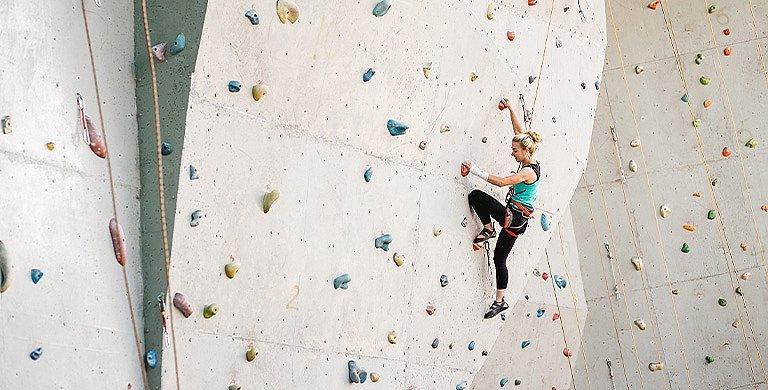OUTDOOR LIFE
Slide Into Curling: A Beginner’s Guide
Curling is one of the fastest growing sports around. Here’s what you need to know and how to get involved.
BY: NANCY BOUCHARD
If curling isn't on your radar, it should be. The sport is blowing up in popularity, much like pickleball
and indoor rock climbing. All you need is ice—indoor or outdoor, doesn't matter—some basic gear, and a willingness to learn. Curling is a cocktail of athleticism, strategy, and social interaction. It’s like the love child of chess and shuffleboard, but with a lot more attitude and less concussion risk. No hard-hitting crashes, just strategy, finesse and, in contrast to many other winter sports, easy to learn. It’s a sport where a 70-year-old grandma and a 20-year-old college kid can play together without anyone getting steamrolled. And while there is still plenty of opportunity to find some wild traditional curling action on frozen lakes, if you want to dip your toe into the sport, your local rink is the place to start.
John Shuster, Columbia Sportswear ambassador and US Curling Team Olympian, shares that “Trying curling is easier than you’d think. Find a club nearby or include a stop in a club while you are traveling.” He notes that most clubs welcome spectators on league nights or offer a weekly learn-to-curl night. “While it may seem intimidating to walk into a club as a newbie,” Shuster acknowledges, “chances are very good someone will recognize you as a beginner, welcome you to the club and offer to teach you about the sport. It would not be surprising if you are throwing some stones by the end of the day.”
Shuster also points out that curling is one of the few sports where Olympic athletes are often found playing league games at their home curling clubs. “The game itself is a tremendous team sport where every player affects every shot.,” explains Shuster. “The best part is the camaraderie--the traditions of sitting with your opponent after a game makes for a very close, large community, both at local clubs and at a larger scale as curlers travel for bonspiels."
Tara Peterson, also a Columbia Sportswear ambassador and US Curling Team Olympian, says that what makes curling fun is that “the game itself is ever evolving.” She notes that like golf, it’s a sport that cannot be truly mastered. “You can have a fantastic day out on the ice and then the next day feel as though you’ve never played the game before,” notes Peterson. “I love the people, the travel and the cultures I’ve learned about, as well as the game itself. People who curl are very welcoming, kind and always willing to teach and educate those interested in the sport.”
Billy Duss, spokesperson for the Bend Curling Club in Oregon, says, “Our club has members ranging from their early 20s to well past retirement age. The real challenge isn't getting people interested—everyone I talk to wants to try curling. It's finding enough ice time to fit them all in.”
“This sport is for everyone,” he says. “I can’t wait to get my baby on the ice!” He points out that, in addition to Wheelchair Curling, one of the six Winter Paralympic sports, the club accommodates all ages and abilities. "We've got kids curling at age 10 and people in their 80s. Some of our older members use a stick to deliver their stones instead of crouching, so there’s no excuse not to play.”
And it’s not just the game that’s inclusive. “Curlers are some of the nicest people you'll meet,” Duss adds. “After a game, we hang out with the other team, have a beer or hot chocolate and have fun. Tradition dictates that the winning team buys the first round." For just $25, the club offers Learn-to-Curl sessions, and they have all the equipment needed to get started.
Curling is a cold-weather addiction, sure, but it's everywhere now—from the frostbitten corners of Canada to warm-weather hotspots like Florida, Texas and Southern California. You’ll find leagues and clubs galore, and the beauty of it? It’s not going to drain your bank account. Grab a broom, join a league, or practice at a public rink, and you’re in for the ride. Just don’t blame us when you find yourself obsessed.
Shuster also points out that curling is one of the few sports where Olympic athletes are often found playing league games at their home curling clubs. “The game itself is a tremendous team sport where every player affects every shot.,” explains Shuster. “The best part is the camaraderie--the traditions of sitting with your opponent after a game makes for a very close, large community, both at local clubs and at a larger scale as curlers travel for bonspiels."
Tara Peterson, also a Columbia Sportswear ambassador and US Curling Team Olympian, says that what makes curling fun is that “the game itself is ever evolving.” She notes that like golf, it’s a sport that cannot be truly mastered. “You can have a fantastic day out on the ice and then the next day feel as though you’ve never played the game before,” notes Peterson. “I love the people, the travel and the cultures I’ve learned about, as well as the game itself. People who curl are very welcoming, kind and always willing to teach and educate those interested in the sport.”
Billy Duss, spokesperson for the Bend Curling Club in Oregon, says, “Our club has members ranging from their early 20s to well past retirement age. The real challenge isn't getting people interested—everyone I talk to wants to try curling. It's finding enough ice time to fit them all in.”
“This sport is for everyone,” he says. “I can’t wait to get my baby on the ice!” He points out that, in addition to Wheelchair Curling, one of the six Winter Paralympic sports, the club accommodates all ages and abilities. "We've got kids curling at age 10 and people in their 80s. Some of our older members use a stick to deliver their stones instead of crouching, so there’s no excuse not to play.”
And it’s not just the game that’s inclusive. “Curlers are some of the nicest people you'll meet,” Duss adds. “After a game, we hang out with the other team, have a beer or hot chocolate and have fun. Tradition dictates that the winning team buys the first round." For just $25, the club offers Learn-to-Curl sessions, and they have all the equipment needed to get started.
Curling is a cold-weather addiction, sure, but it's everywhere now—from the frostbitten corners of Canada to warm-weather hotspots like Florida, Texas and Southern California. You’ll find leagues and clubs galore, and the beauty of it? It’s not going to drain your bank account. Grab a broom, join a league, or practice at a public rink, and you’re in for the ride. Just don’t blame us when you find yourself obsessed.
A Brief History: From Scotland to the Olympics
Curling dates to the 16th century in Scotland, where it was played on frozen lochs. The oldest known curling stone, on display in Stirling, Scotland, is inscribed with the date 1511. The sport is a relic of a time when men wore kilts and flung rocks with wild abandon. Fast forward to today, and you’ll find people kitted out with long pants, snug jackets and special shoes, although no one would complain if you sported your family tartan. The game originated as a social event, but quickly evolved with formal rules and an international following. It spread like wildfire to Canada, where it found fertile ground and turned into a national obsession, like maple syrup and hockey. Curling was introduced as a demonstration sport in the 1924 Chamonix Winter Games and achieved global recognition when it became an official Winter Olympic sport in 1998. Today, it’s enjoyed by millions of people around the world, with strong communities in Canada, Sweden, Norway, and Switzerland. There are about 200 curling clubs in the US, and more than 1000 in Canada.
Why Try Curling?
Curling requires raw strength; instead, precision, finesse, and teamwork are all key factors to success. The goal is to slide heavy stones toward a target, called the “house,” while teammates sweep the ice to control the stone’s speed and direction. It’s not just about winning; it’s about having fun, getting some exercise, and enjoying time with others. Plus, there’s something incredibly satisfying about hearing a stone as it slides across the ice and the whoops of joy when it reaches its intended destination.
What You Need to Know
1. The Basics
Curling is played on an ice rink with two teams of four players each. Teams take turns sliding the 42-pound stones toward the “house,” aiming to get as close as possible to the center, known as the “button.” Teammates use brooms to sweep the ice ahead of the stone, guiding its path.
2. The Gear
You can use your own apparel and footwear to start out. Dress warm, with layers that you can remove when you heat up. You can buy curling-specific apparel, but ski clothes, like winter pants and insulated jacket will work just fine. Most curlers wear a jacket that doesn’t restrict movement, stretchy pants or thick tights, and warm socks. You can curl with regular winter boots or rubber soled shoes, but ideally, you’ll wear two different shoes—one with a slick sole for sliding and the other with a grippy rubber sole for traction and stability. You can rent shoes from the curling club, as well as stones and brooms.
3. The Social Side
While there are highly competitive curling divisions, including Olympic, World Cup, college, high school and local leagues, a lot of people simply get involved to stay fit, make friends and have fun. Curling is all about community—after the match, it can be as much about the après-curl as it is about the game itself. Sometimes, the real action happens off the ice, where players gather to swap stories, sip a drink, and relive the match's highlights. In addition to “learn-to-curl” events and beginner leagues, many clubs host social nights where you can meet new people in a relaxed, pressure-free environment.
Getting Started
1. Find a Club
The first step is to locate a local curling rink or club. If you live in a colder climate, chances are you’ll have at least one in your town; but there are USA Curling sanctioned clubs in nearly every state in the union, including California, Texas and Florida.
2. Take a Lesson
Sign up for a “learn-to-curl” class or join a beginner’s league. These classes provide a great introduction to the game, teaching the basics of stone delivery, sweeping, and strategy, with plenty of guidance from experienced players. And remember, you don’t need to know how to ice skate to curl, since you wear shoes, not skates.
3. Hit the Ice
You can practice some of the movements on dry land and there are plenty of instructional videos on the internet, but don’t be afraid of moving out onto the ice. Whether you’re joining a league or just attending an open ice session, you’ll quickly start refining skills and developing your own style. And yes, you might slip a few times, but that’s all part of the learning process. If you are worried about falling, wear knee and elbow pads.
4. Practice Makes Perfect
As with any sport, practice is key. The more you throw stones and work with your teammates, the better you’ll get. Don’t worry about perfection—like bowling and golf—those perfect moments are rare but highly addictive. Your next step? Join a local curling league.
5. Watch and Learn
Watching professional games, like the Winter Olympics or World Curling Championships, is a great way to pick up strategies and techniques. There is even a Curling Channel you can subscribe to.
6. Participate in Bonspiels
A bonspiel is a tournament or event with multiple teams, prizes, food, drink and even costumes. The term is Scottish in origin and translates to "good play." Bonspiels are all about fun, camaraderie and of course friendly competition. At some Bonspiels, curlers compete in costume, wearing everything from tuxedos to cowboy attire.
Fun Facts About Curling
1. Chess on Ice
Curling involves a lot of strategy. Players must think several steps ahead, considering the position of other stones and how best to outmaneuver their opponents.
2. Rock Solid
Curling stones are made from a special type of granite found in a quarry in Wales and on a small Scottish island. The stones are polished to ensure they glide smoothly across the ice.
3. The Curl Comes from the Rotation
The sport’s name comes from the stone’s curl or rotation. When released with a slight spin, the stone curves as it slides across the ice, adding a layer of skill and precision to the game.
4. Specially Prepared Ice
Curling ice is meticulously prepared with an ice grooming machine and then sprayed with water to create tiny bumps or "pebbles" that help the stone glide and curl. The pebbles also provide resistance, adding to the strategic nature of the game.
5. The Sweeping Effect
Sweeping in front of the stone can warm the ice slightly and reduce friction, making the stone travel further and straighter. It’s a key skill for controlling the stone’s path and maximizing precision.
6. Accessibility For All
Wheelchair Curling was first introduced as a Paralympic sport in 2006. Many curling clubs offer adaptive curling, either with wheelchairs or other adaptive devices. In Canada and Norway, accessible curling programs are frequently integrated into their regular curling leagues.
7. The Button
The button is the center of the curling target, called the “house.” The team with the stone closest to the button wins the “end,” or round of play.
8. The Skip
The skip is the team captain, responsible for calling the shots and directing teammates. The skip plays a key role in strategy and decision-making throughout the game.
9. Long Distances
Curling stones can travel over 100 feet, depending on how well the player delivers the stone and how much sweeping is done.
10. Ten Ends
A game of curling consists of 10 "ends" (like innings in baseball). Each team takes turns sliding stones, and after 10 ends, the team with the most points wins.
11. Curling Etiquette
Respect and sportsmanship are central to curling, in fact, curling is known as “a game of honor” with a proud “spirit of curling” that’s central to the sport. Competitors shake hands before and after games, and it’s common for players to applaud great shots by either team, like in a game of pool. Also, like in golf, curlers often call their own fouls, like “burned stones,” “stone delivery,” and “moving the stone.”
12. Canada’s Dominance
Canada is the undisputed king of curling these days—especially when it comes to the Olympics and World Championships. But make no mistake, teams from all over the globe are crashing the party, ready to take a shot at the throne.



